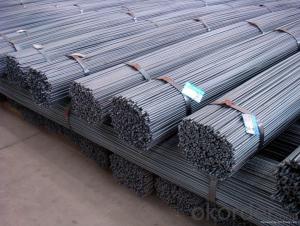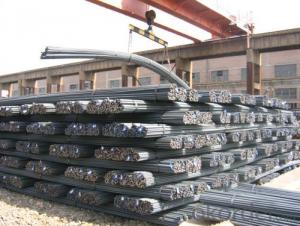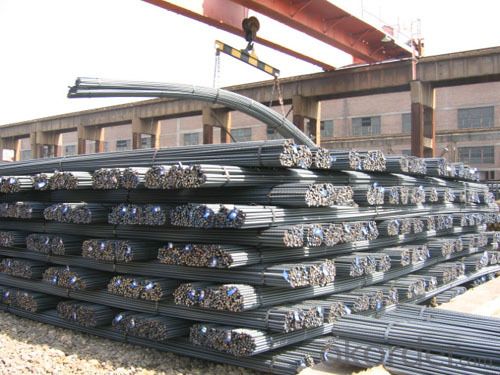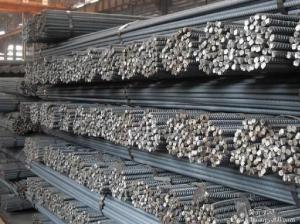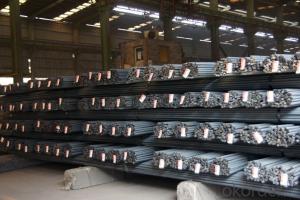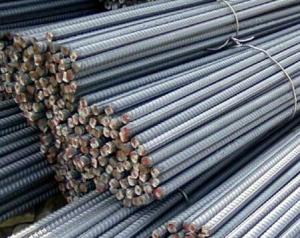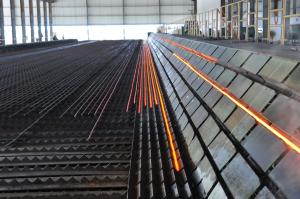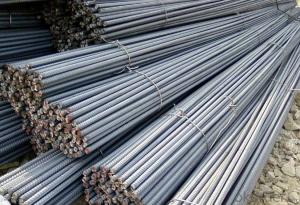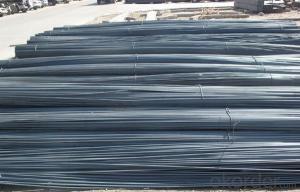Deformed bars in Grade HRB400 with High Quality
- Loading Port:
- Tianjin
- Payment Terms:
- TT OR LC
- Min Order Qty:
- 25 m.t.
- Supply Capability:
- 100000 m.t./month
OKorder Service Pledge
OKorder Financial Service
You Might Also Like
Product Description:
Specifications of HRB400 Deformed Steel Bar:
Standard | GB | HRB400 | |
Diameter | 6mm,8mm,10mm,12mm,14mm,16mm,18mm,20mm, 22mm,25mm,28mm,32mm,36mm,40mm,50mm | ||
Length | 6M, 9M,12M or as required | ||
Place of origin | Hebei, China mainland | ||
Advantages | exact size, regular package, chemical and mechanical properties are stable. | ||
Type | Hot rolled deformed steel bar | ||
Brand name | DRAGON | ||
Chemical Composition: (Please kindly find our chemistry of our material based on HRB500 as below for your information)
Grade | Technical data of the original chemical composition (%) | ||||||
C | Mn | Si | S | P | V | ||
HRB400 | ≤0.25 | ≤1.60 | ≤0.80 | ≤0.045 | ≤0.045 | 0.04-0.12 | |
Physical capability | |||||||
Yield Strength (N/cm²) | Tensile Strength (N/cm²) | Elongation (%) | |||||
≥400 | ≥570 | ≥14 | |||||
Theoretical weight and section area of each diameter as below for your information:
Diameter(mm) | Section area (mm²) | Mass(kg/m) | Weight of 12m bar(kg) |
6 | 28.27 | 0.222 | 2.664 |
8 | 50.27 | 0.395 | 4.74 |
10 | 78.54 | 0.617 | 7.404 |
12 | 113.1 | 0.888 | 10.656 |
14 | 153.9 | 1.21 | 14.52 |
16 | 201.1 | 1.58 | 18.96 |
18 | 254.5 | 2.00 | 24 |
20 | 314.2 | 2.47 | 29.64 |
22 | 380.1 | 2.98 | 35.76 |
25 | 490.9 | 3.85 | 46.2 |
28 | 615.8 | 4.83 | 57.96 |
32 | 804.2 | 6.31 | 75.72 |
36 | 1018 | 7.99 | 98.88 |
40 | 1257 | 9.87 | 118.44 |
50 | 1964 | 15.42 | 185.04 |
Usage and Applications of HRB400 Deformed Steel Bar:
Deformed bar is widely used in buildings, bridges, roads and other engineering construction. Big to highways, railways, bridges, culverts, tunnels, public facilities such as flood control, dam, small to housing construction, beam, column, wall and the foundation of the plate, deformed bar is an integral structure material. With the development of world economy and the vigorous development of infrastructure construction, real estate, the demand for deformed bar will be larger and larger..
Packaging & Delivery of HRB400 Deformed Steel Bar:
Packaging Detail: products are packed in bundle and then shipped by container or bulk vessel, deformed bar is usually naked strapping delivery, when storing, please pay attention to moisture proof. The performance of rust will produce adverse effect.
Each bundle weight: 2-3MT, or as required
Payment term: TT or L/C
Delivery Detail: within 45 days after received advanced payment or LC.
Label: to be specified by customer, generally, each bundle has 1-2 labels
Trade terms: FOB, CFR, CIF
- Q: What are the maintenance requirements for steel rebars in a structure?
- The maintenance requirements for steel rebars in a structure are crucial to ensure the stability and longevity of the building. Steel rebars, also known as reinforcing bars, are used to enhance the strength of concrete structures and resist tension forces. Here are some key maintenance requirements to consider: 1. Visual Inspection: Regular visual inspections should be conducted to detect any signs of corrosion, cracks, or damage in the rebars. This can be done by qualified personnel who have knowledge and experience in identifying structural issues. 2. Cleaning: The rebars should be kept clean from any debris, dirt, or chemicals that can accelerate corrosion. Adequate cleaning methods, such as using water and mild detergents, should be employed to maintain their condition. 3. Corrosion Protection: Steel rebars are susceptible to corrosion, especially in environments with high humidity, exposure to saltwater, or chemical pollutants. Applying protective coatings like epoxy or zinc can help prevent or delay corrosion, increasing the rebars' lifespan. 4. Repair or Replacement: If any rebars are found to be severely corroded, cracked, or damaged, it is essential to repair or replace them promptly. Ignoring these issues can compromise the structural integrity of the building and lead to safety hazards. 5. Monitoring: Continuous monitoring of the rebars' condition is recommended to detect any changes or deterioration over time. This can involve using advanced techniques like ultrasonic testing or electrical potential measurements to assess the rebars' integrity. 6. Proper Drainage: Ensuring proper drainage systems in the structure can help prevent water accumulation and reduce the chances of corrosion in the rebars. Properly designed and maintained gutters, downspouts, and waterproofing measures can help minimize water exposure. 7. Regular Maintenance Schedule: Establishing a regular maintenance schedule is crucial to ensure that all the necessary inspections, cleaning, and repairs are carried out systematically. This helps in identifying potential issues early on and taking corrective actions promptly. By adhering to these maintenance requirements, the steel rebars in a structure can be preserved, contributing to the overall safety, durability, and longevity of the building. Regular maintenance not only prevents costly repairs but also ensures the structural integrity required for the safety of occupants and the longevity of the structure.
- Q: What is the lifespan of steel rebars in marine structures?
- The lifespan of steel rebars in marine structures can vary depending on various factors such as the quality of the steel, the environment in which they are exposed, and the maintenance practices employed. However, properly designed, constructed, and maintained marine structures with steel rebars can typically have a lifespan of 50 to 100 years. Steel rebars used in marine structures are generally coated with corrosion-resistant materials, such as epoxy or zinc, to protect them from the harsh marine environment. These coatings provide an additional layer of defense against corrosion, extending the lifespan of the rebars. However, it is important to note that the marine environment is highly corrosive due to the presence of saltwater, humidity, and other corrosive agents. Over time, these factors can lead to the degradation of the protective coatings and the exposure of the rebars to corrosion. If adequate maintenance measures are not taken, such as regular inspections, cleaning, and reapplication of protective coatings, the rebars may experience accelerated corrosion and their lifespan may be shortened. Additionally, the design and construction of marine structures play a crucial role in determining the lifespan of steel rebars. Proper considerations must be given to factors such as structural design, material selection, and detailing to minimize the risk of corrosion and ensure the longevity of the rebars. In summary, the lifespan of steel rebars in marine structures can range from 50 to 100 years, depending on factors such as the quality of the steel, the environmental conditions, and the maintenance practices employed. Proper design, construction, and maintenance are essential to maximizing the lifespan of steel rebars in marine structures.
- Q: How do steel rebars resist corrosion?
- Steel rebars resist corrosion through a process called passivation. When the steel is exposed to air and moisture, a thin layer of iron oxide forms on its surface, which acts as a protective barrier against further corrosion. This layer, also known as rust, prevents oxygen and moisture from reaching the inner layers of steel, thereby preventing further oxidation. Additionally, steel rebars are often coated with materials such as epoxy or zinc to provide an extra layer of protection against corrosion. These coatings act as a physical barrier between the steel and the environment, preventing contact with corrosive elements. Regular maintenance, such as cleaning and applying protective coatings, can also help to extend the lifespan of steel rebars and prevent corrosion.
- Q: How are steel rebars spliced or connected in construction joints?
- Steel rebars are typically spliced or connected in construction joints using several methods, including lap splicing, mechanical splicing, and welded splicing. Lap splicing involves overlapping the rebars and tying them together with wire or steel bars, ensuring proper alignment and contact between the rebars. Mechanical splicing utilizes couplers or threaded sleeves to connect the rebars, providing a stronger and more efficient joint. Welded splicing involves welding the rebars together, ensuring a secure and durable connection. The choice of splicing method depends on factors such as the project requirements, structural design, and construction site conditions.
- Q: Can steel rebars be used in structures with high aesthetic requirements?
- Indeed, structures with high aesthetic standards can make use of steel rebars. Although steel rebars are mainly employed for their robustness and longevity, they can also be fashioned and integrated in a manner that satisfies aesthetic necessities. Rebars have the potential to be molded, curved, or even coated to align with the desired visual appeal of the structure. Furthermore, they can be concealed within the framework or concealed under alternate materials to preserve a pristine and visually captivating facade. Through meticulous forethought and design, steel rebars can be effectively employed in structures with demanding aesthetic prerequisites without compromising their functionality or visual allure.
- Q: How do steel rebars contribute to the structural integrity of a building during earthquakes?
- Steel rebars contribute to the structural integrity of a building during earthquakes by providing reinforcement and strength to the concrete. The rebars are embedded within the concrete, forming a reinforced concrete structure that can withstand the forces generated by seismic activity. This helps to distribute the load evenly throughout the building, reducing the risk of collapse or significant damage during an earthquake.
- Q: How are steel rebars classified based on their diameter?
- Steel rebars are classified based on their diameter into different sizes, which usually range from 6 to 50 millimeters.
- Q: What are the advantages of using stainless steel rebars?
- Using stainless steel rebars in construction projects offers several advantages. Firstly, these rebars have a remarkable resistance to corrosion, making them perfect for structures in harsh environments such as coastal or industrial areas. Unlike traditional carbon steel rebars, stainless steel rebars do not easily rust or corrode, ensuring the durability and longevity of the structure. Secondly, stainless steel rebars possess a higher tensile strength compared to carbon steel rebars. This means they can endure greater stress and loads without deforming or breaking, resulting in a safer and more reliable structure. Moreover, their high tensile strength allows for the utilization of smaller rebars, which saves construction costs and reduces the overall weight of the structure. Furthermore, stainless steel rebars exhibit excellent fire resistance properties. They retain their strength and integrity much better than carbon steel in the event of a fire, reducing the risk of structural collapse. This is particularly crucial in buildings with high fire safety requirements, such as hospitals, schools, and high-rise structures. Another advantage of stainless steel rebars is their low maintenance requirements. Due to their corrosion resistance, they do not need regular inspections or costly protective coatings. This saves both time and money in maintenance efforts. Lastly, stainless steel rebars are highly sustainable and environmentally friendly. They are 100% recyclable, reducing the demand for new raw materials and minimizing waste in construction projects. Additionally, the long lifespan of stainless steel rebars reduces the need for frequent replacements, further minimizing the environmental impact. To summarize, the benefits of using stainless steel rebars include excellent corrosion resistance, high tensile strength, superior fire resistance, low maintenance requirements, and sustainability. These advantages make stainless steel rebars the preferred choice for construction projects that prioritize durability, safety, and long-term value.
- Q: What is the role of steel rebars in the construction of railway bridges?
- Steel rebars play a crucial role in the construction of railway bridges by providing reinforcement and strength to the concrete structure. They help to distribute the load evenly across the bridge, ensuring its stability and durability, especially when subjected to heavy train traffic and varying weather conditions. Rebars also help to prevent cracks and structural failures, making them an essential component in ensuring the safety and longevity of railway bridges.
Send your message to us
Deformed bars in Grade HRB400 with High Quality
- Loading Port:
- Tianjin
- Payment Terms:
- TT OR LC
- Min Order Qty:
- 25 m.t.
- Supply Capability:
- 100000 m.t./month
OKorder Service Pledge
OKorder Financial Service
Similar products
Hot products
Hot Searches
Related keywords
